belt Oldsmobile Aurora 1998 s Owner's Guide
[x] Cancel search | Manufacturer: OLDSMOBILE, Model Year: 1998, Model line: Aurora, Model: Oldsmobile Aurora 1998Pages: 380, PDF Size: 19.75 MB
Page 37 of 380
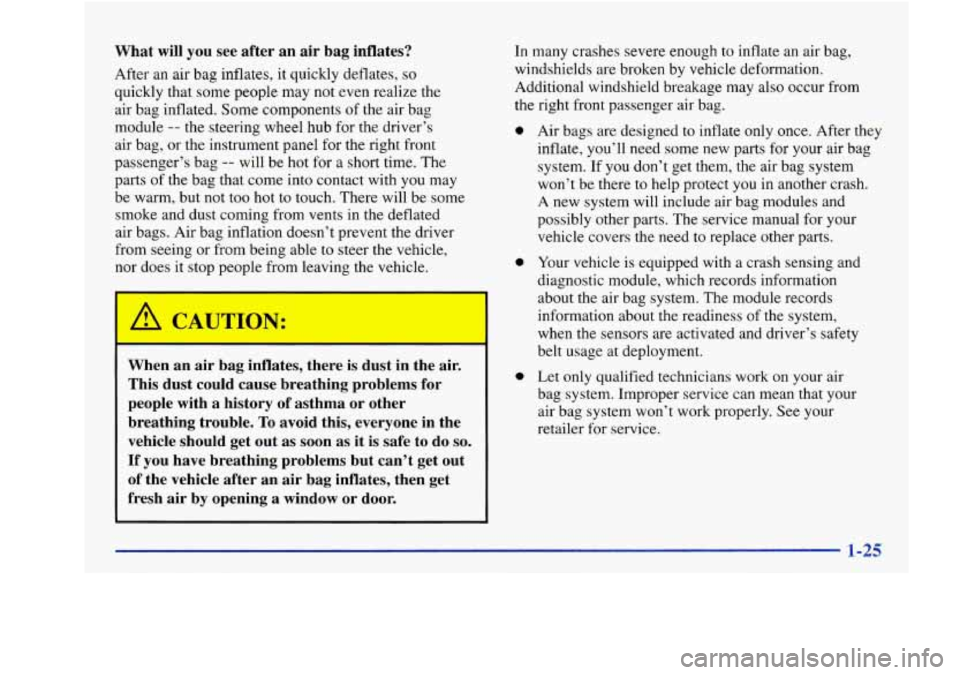
What will you see after an air bag inflates?
After an air bag inflates, it quickly deflates, so
quickly that some people may not even realize the
air bag inflated. Some components
of the air bag
module
-- the steering wheel hub for the driver’s
air bag, or the instrument panel for the right front
passenger’s bag
-- will be hot for a short time. The
parts of the bag that come into contact with you may
be warm, but not too hot to touch. There will be some
smoke and dust coming from vents in the deflated
air bags. Air bag inflation doesn’t prevent the driver
from seeing or from being able to steer the vehicle,
nor does it stop people from leaving the vehicle.
I
When an air bag inflates, there is dust in the air.
This dust could cause breathing problems for
people with a history
of asthma or other
, breathing trouble. To avoid this, everyone in the
vehicle should get out as soon as it is safe to
do so.
If you have breathing problems but can’t get out
of the vehicle after an air bag inflates, then get
fresh air by opening a window or door.
In many crashes severe enough to inflate an air bag,
windshields are broken by vehicle deformation.
Additional windshield breakage may
also occur from
the right front passenger air bag.
Air bags are designed to inflate only once. After they,
inflate, you’ll need some new parts for your air bag
system.
If you don’t get them, the air bag system
won’t be there to help protect you in another crash.
A new system will include air bag modules and
possibly other parts. The service manual for your
vehicle covers the need to replace other parts.
Your vehicle is equipped with a crash sensing and
diagnostic module, which records information
about the air bag system. The module records
information about the readiness of the system,
when the sensors
are activated and driver’s safety
belt usage at deployment.
Let only qualified technicians work on your air
bag system. Improper service can mean that your
air bag system won’t work properly. See your
retailer for service.
Page 39 of 380
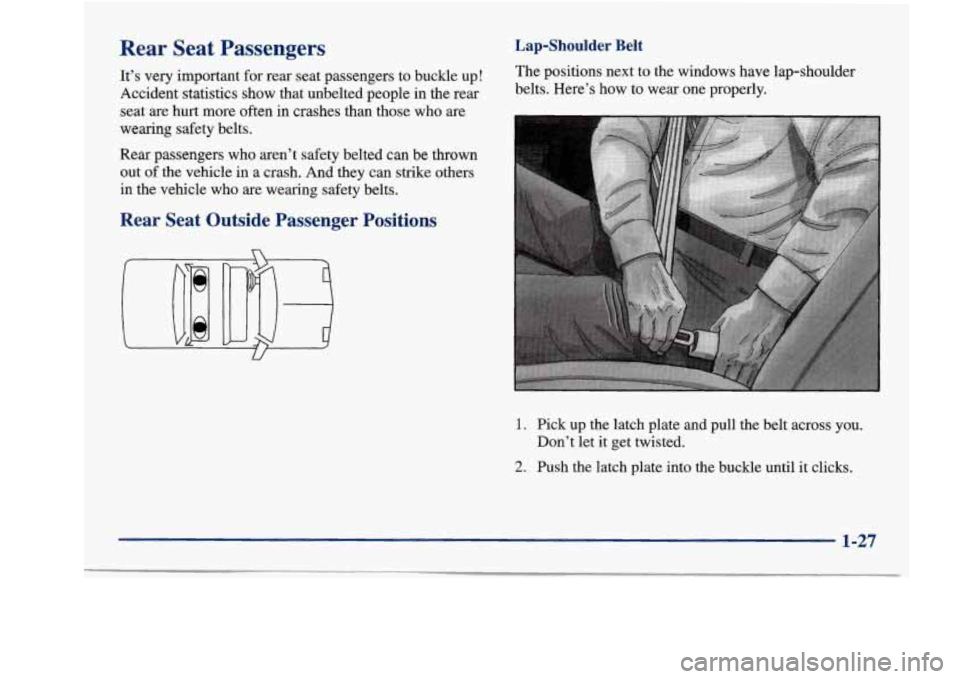
Rear Seat Passengers
It’s very important for rear seat passengers to buckle up!
Accident statistics show that unbelted people in the rear
seat
are hurt more often in crashes than those who are
wearing safety belts.
Rear passengers who aren’t safety belted can be thrown
out
of the vehicle in a crash. And they can strike others
in the vehicle who are wearing safety belts.
Rear Seat Outside Passenger Positions
Lap-Shoulder Belt
The positions next to the windows have lap-shoulder
belts. Here’s how to wear one properly.
1. Pick up the latch plate and pull the belt across you.
Don’t let it get twisted.
2. Push the latch plate into the buckle until it clicks.
1-27
Page 40 of 380
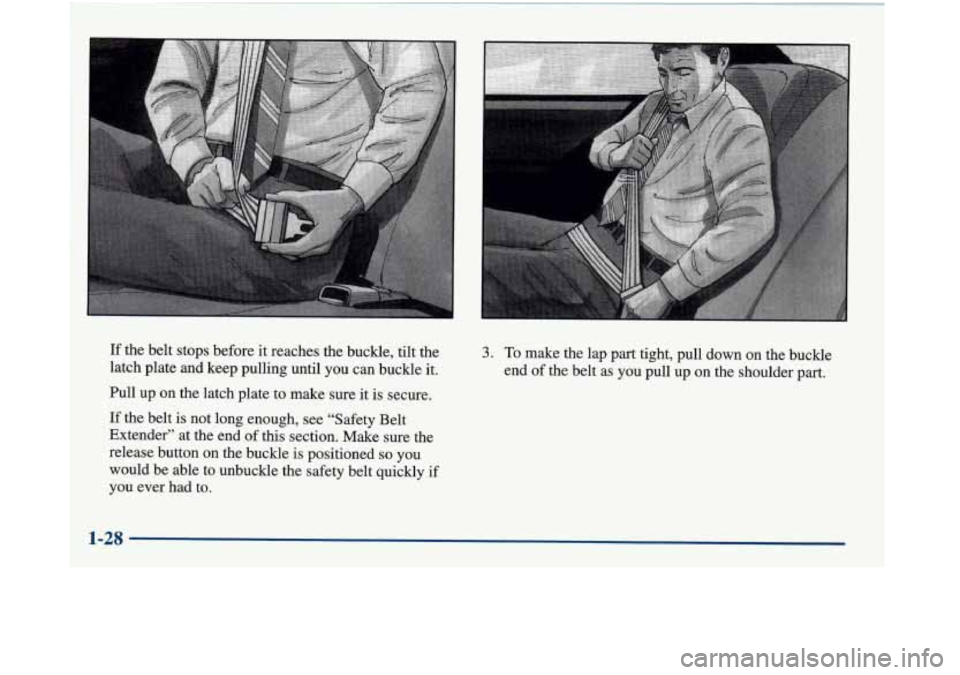
If the belt stops before it reaches the buckle, tilt the
latch plate and keep pulling until you can buckle it.
Pull up on the latch plate to make sure it is secure.
If the belt
is not long enough, see “Safety Belt
Extender” at the end of
this section. Make sure the
release button on the buckle is positioned
so you
would be able to unbuckle the safety belt quickly if
you ever had to.
3. To make the lap part tight, pull down on the buckle
end of the belt
as you pull up on the shoulder part.
1-28
Page 41 of 380
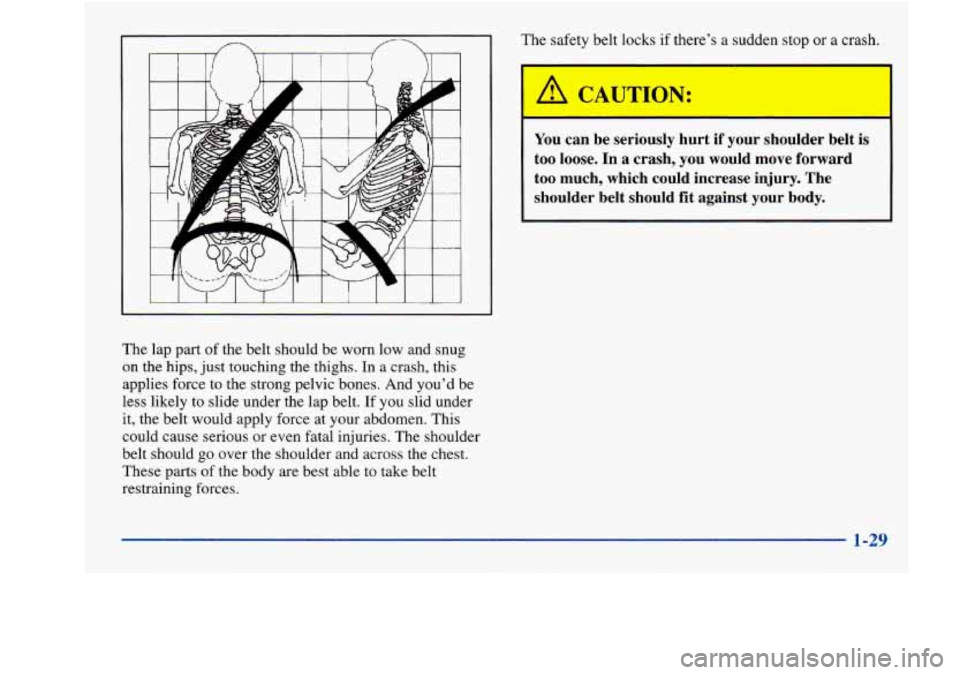
The lap part of the belt should be worn low and snug
on the hips, just touching the thighs. In a crash, this
applies force to the strong pelvic bones. And you’d be
less likely to slide under the lap belt. If you slid under
it, the belt would apply force at your abdomen. This
could cause serious
or even fatal injuries. The shoulder
belt should go over the shoulder and across the chest.
These parts of the body are best able to take belt
restraining forces. The
safety belt locks if there’s a sudden stop or a crash.
You can be seriously hurt if your shoulder belt is
too loose. In a crash, you would move forward
too much, which could increase injury. The
shoulder belt should fit against your body.
1-29
Page 42 of 380
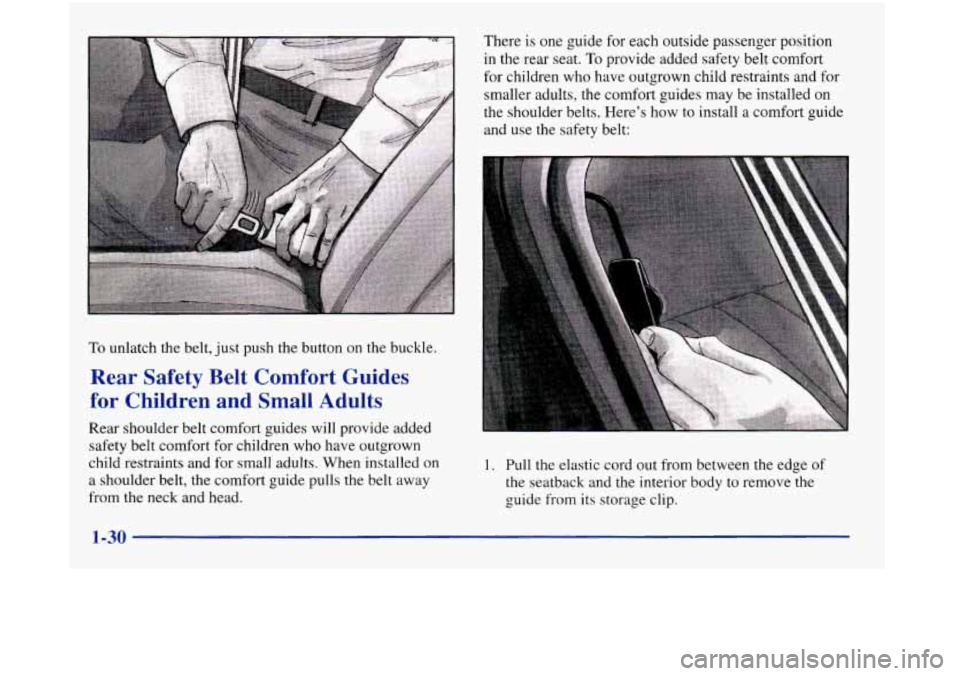
To unlatch the belt, just push the button on the buckle.
Rear Safety Belt Comfort Guides
for Children and Small Adults
Rear shoulder belt comfort guides will provide added
safety belt comfort for children who have outgrown
child restraints and for small adults. When installed on
a shoulder belt, the comfort guide pulls the belt away
from the neck and head. There is one
guide for each outside passenger position
in the rear seat.
To provide added safety belt comfort
for children who have outgrown child restraints and for
smaller adults, the comfort guides may be installed on
the shoulder belts. Here’s how to install a comfort guide
and use the safety belt:
1. Pull the elastic cord out from between the edge of
the seatback and the interior body to remove the
guide
from its storage clip.
1-30
Page 43 of 380
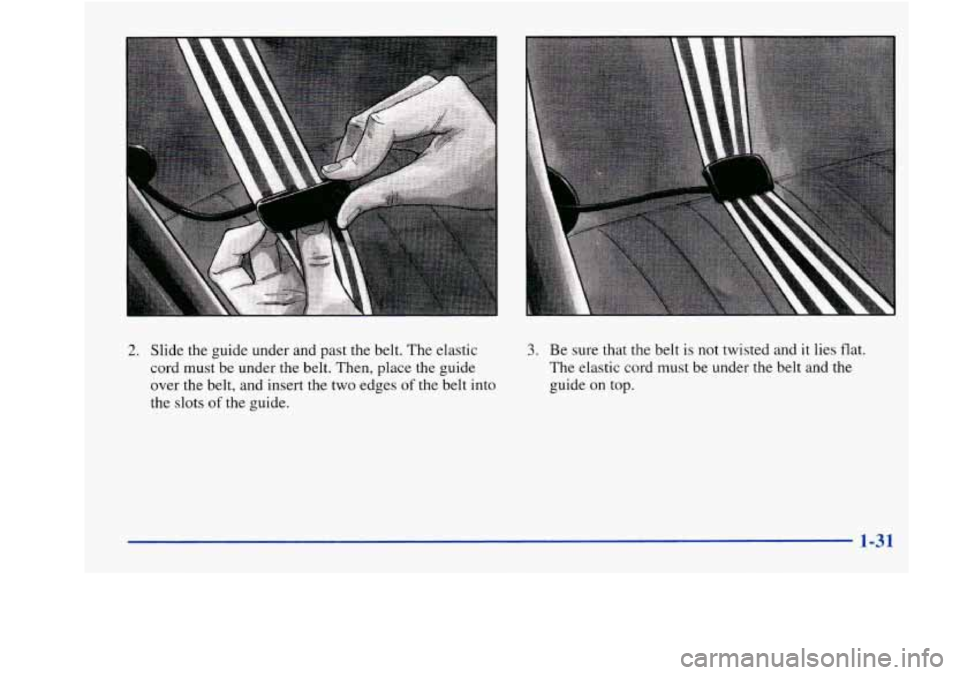
2. Slide the guide under and past the belt. The elastic
cord must be under the belt. Then, place the guide
over the belt, and insert the two edges
of the belt into
the slots
of the guide.
3. Be sure that the belt is not twisted and it lies flat.
The elastic cord must be under the belt and the
guide
on top.
1-31
,
Page 44 of 380
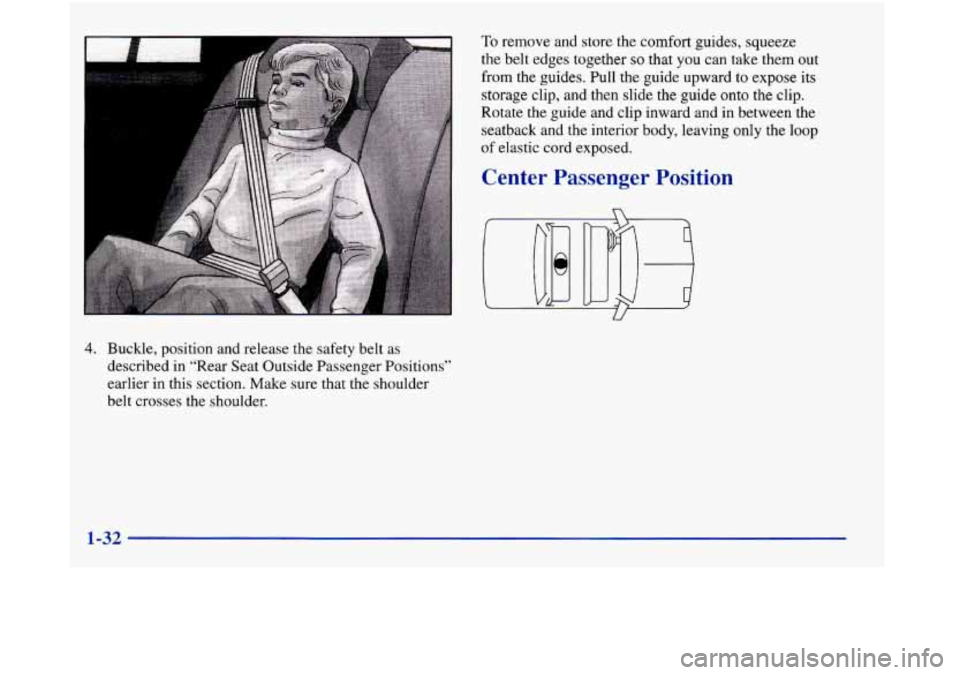
To remove and store the comfort guides, squeeze
the belt edges together
so that you can take them out
from the guides. Pull the guide upward to expose its
storage clip, and then slide the guide onto the clip.
Rotate the guide and clip inward and in between the
seatback and the interior body, leaving only the loop
of elastic cord exposed.
Center Passenger Position
4. Buckle, position and release the safety belt as
described in “Rear Seat Outside Passenger Positions”
earlier in this section. Make sure that the shoulder
belt crosses the shoulder.
1-32
Page 45 of 380
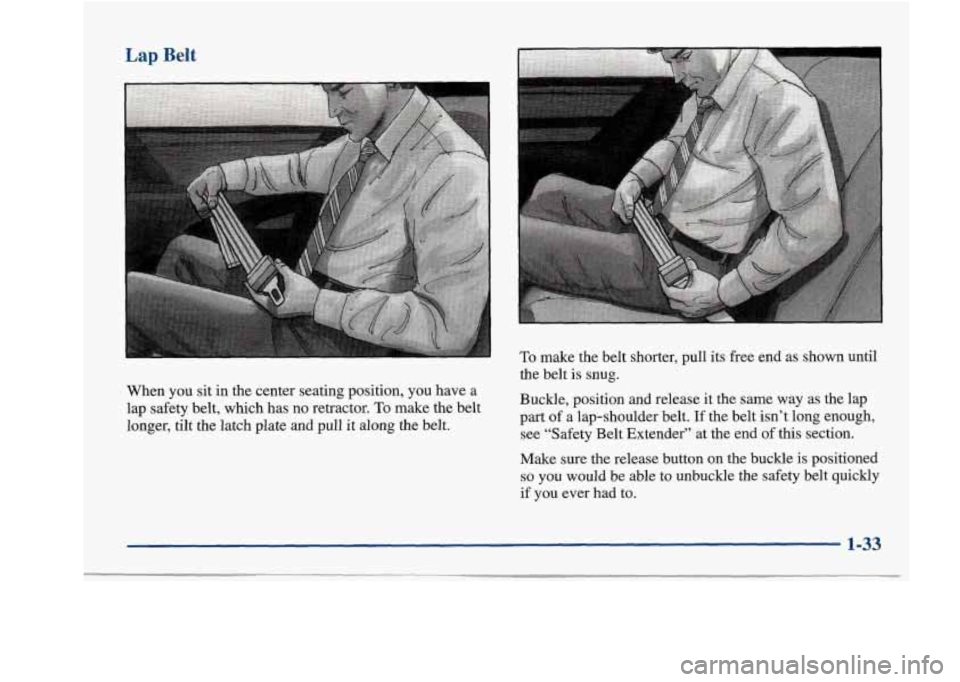
Lap Belt
1
When you sit in the center seating position, you have a
lap safety belt, which has no retractor.
To make the belt
longer, tilt the latch plate and pull it along the belt.
To make the belt shorter, pull its free end as shown until
the belt is snug.
Buckle, position and release it the same way as the lap
part
of a lap-shoulder belt. If the belt isn’t long enough,
see “Safety Belt Extender” at the end
of this section.
Make sure the release button
on the buckle is positioned
so you would be able to unbuckle the safety belt quickly
if you ever had to.
1-33
Page 46 of 380
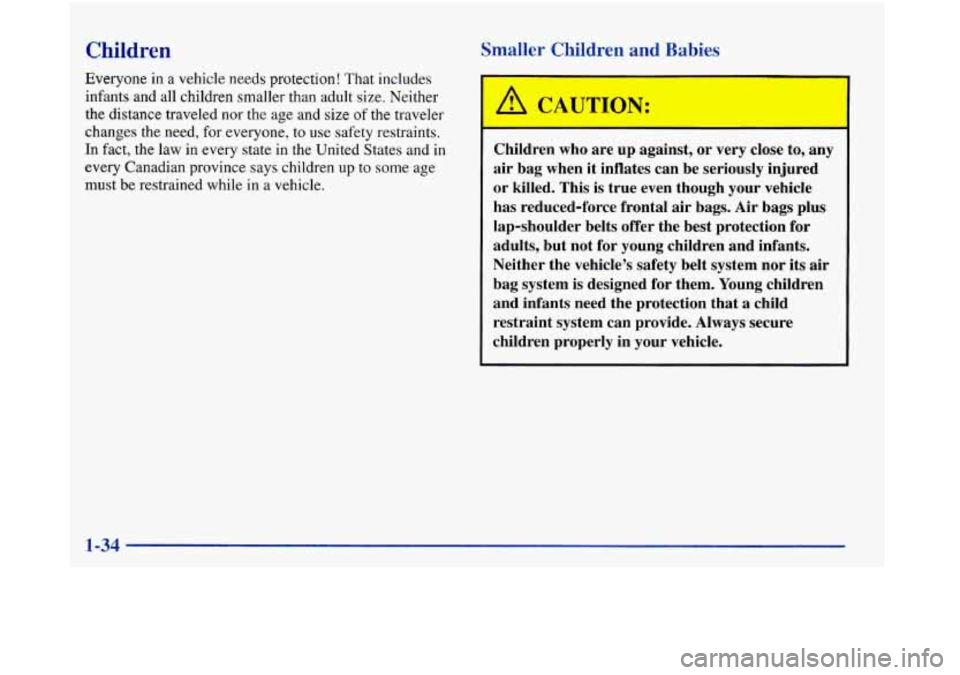
Children
Everyone in a vehicle needs protection! That includes
infants and all children smaller than adult size. Neither
the distance traveled nor the age and
size of the traveler
changes the need, for everyone, to use safety restraints.
In fact, the law in every state in the United States and in
every Canadian province
says children up to some age
must
be restrained while in a vehicle.
Smaller Children and Babies
TTTi3N:
Children who are up against, or very close to, any
air bag when it inflates can be seriously injured
or killed. This is true even though your vehicle
has reduced-force frontal air bags. Air bags plus
lap-shoulder belts offer the best protection for
adults, but not for young children and infants.
Neither the vehicle’s safety belt system nor its air
bag system is designed for them. Young children
and infants need the protection that a child
restraint system can provide. Always secure
children properly in your vehicle.
1-34
Page 47 of 380
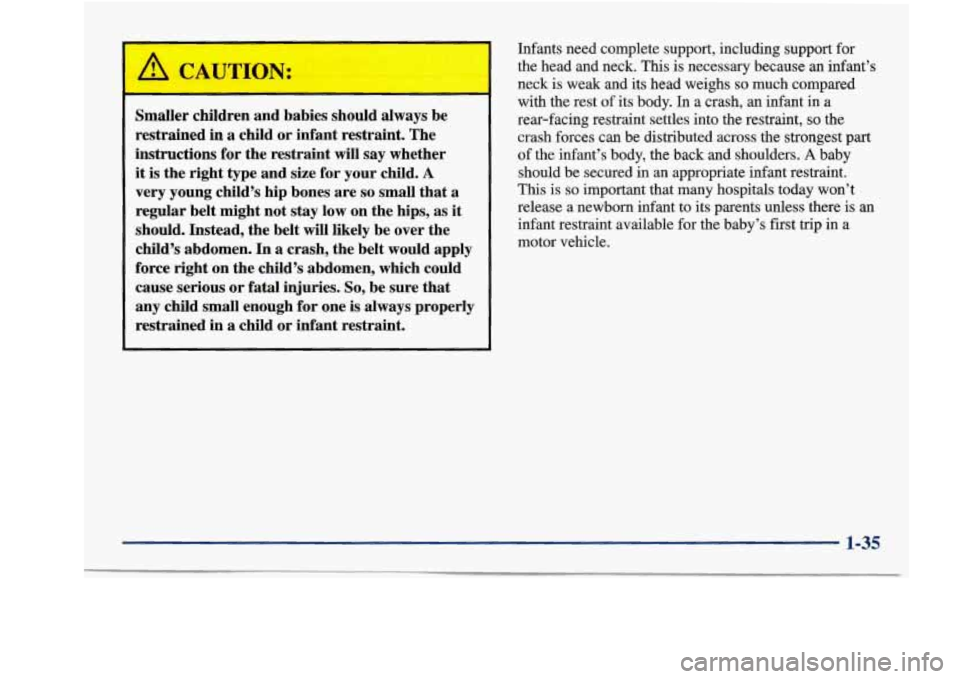
A -AUTION:
Smaller children and babies should always be
restrained in a child or infant restraint. The
instructions for the restraint will say whether
it is the right type and size for your child.
A
very young child’s hip bones are so small that a
regular belt might not stay low on the hips, as
it
should. Instead, the belt will likely be over the
child’s abdomen.
In a crash, the belt would apply
force right on the child’s abdomen, which could
cause serious or fatal injuries.
So, be sure that
any child small enough for one is always properly
restrained in a child or infant restraint.
Infants need complete support, including support for
the head and neck. This is necessary because an infant’s
neck is weak and its head weighs
so much compared
with the rest of its body.
In a crash, an infant in a
rear-facing restraint settles
into the restraint, so the
crash forces can be distributed across the strongest part
of the infaIit’s body, the back
and shoulders. A baby
should be secured in an appropriate infant restraint.
This is so important that many hospitals today won’t
release a newborn infant to its parents unless there
is an
infant restraint available for the baby’s first trip in a
motor vehicle.
1-35